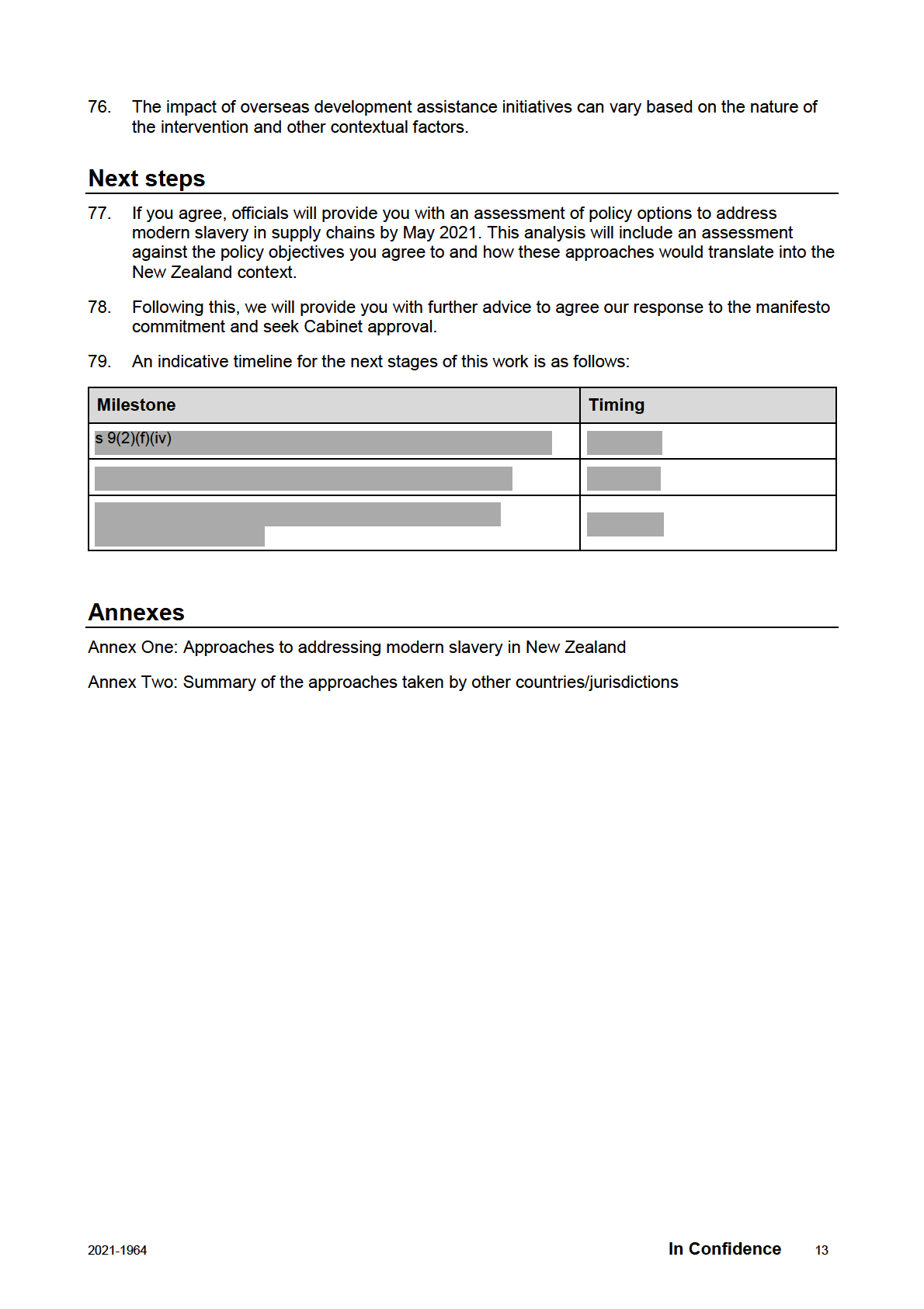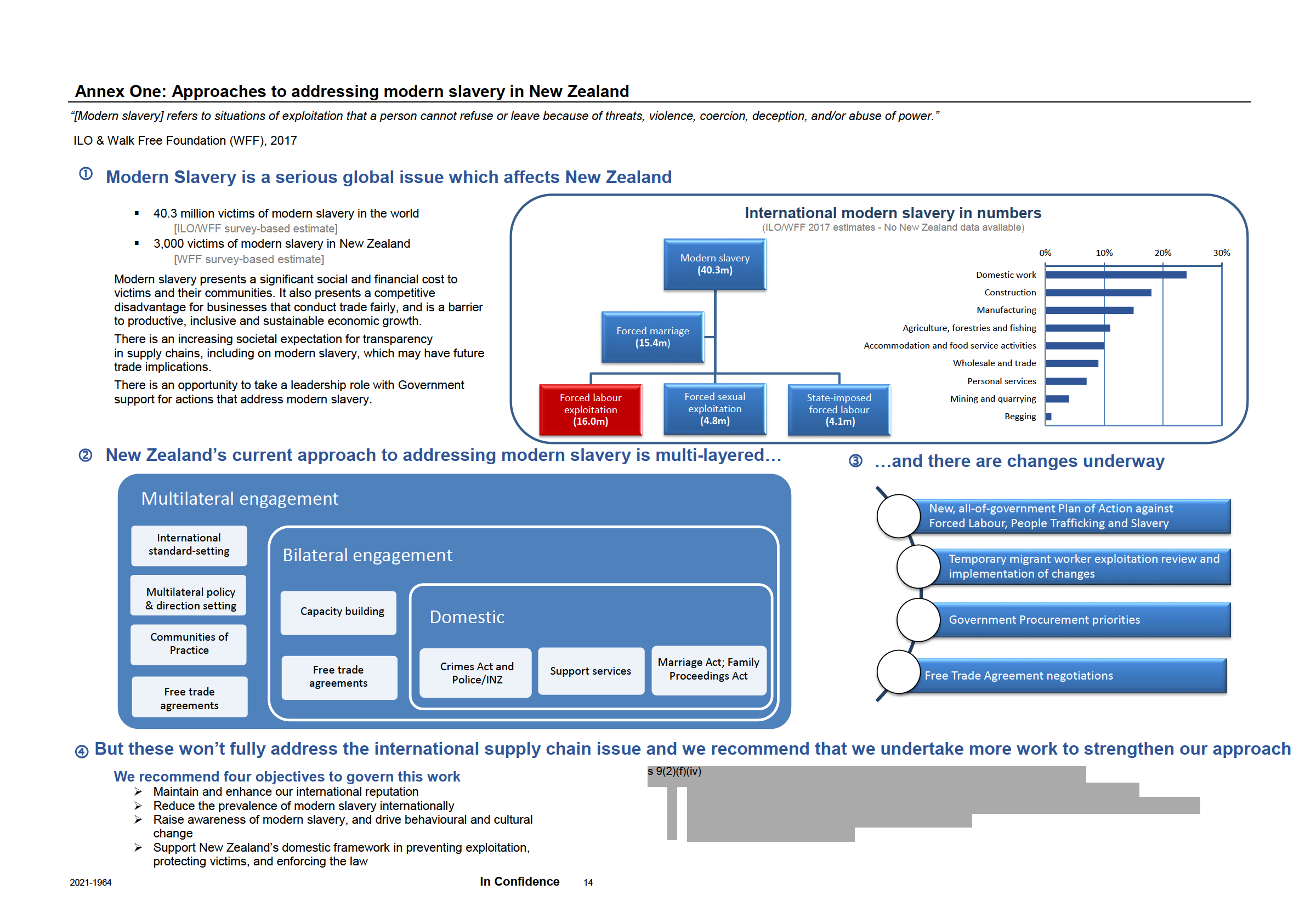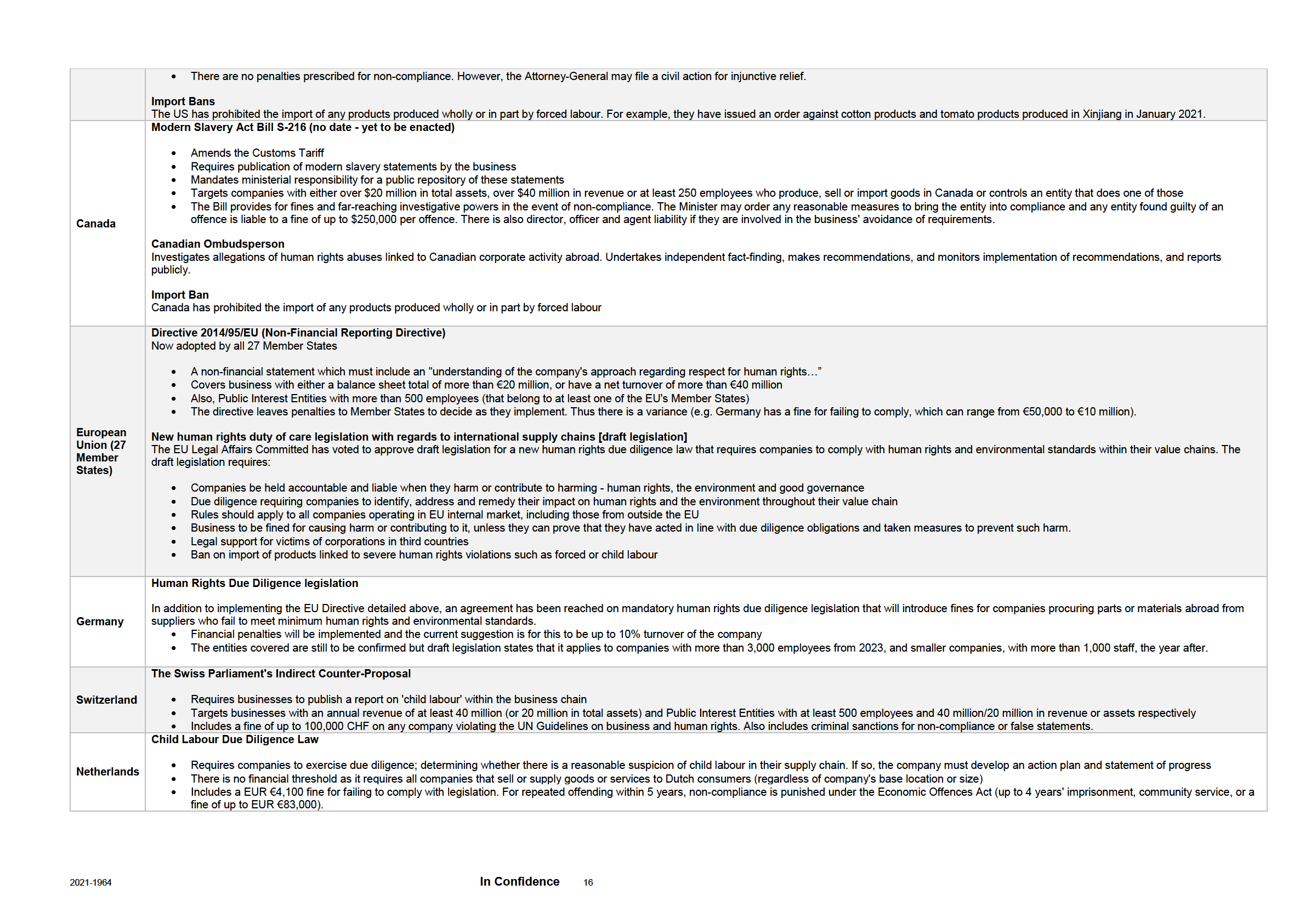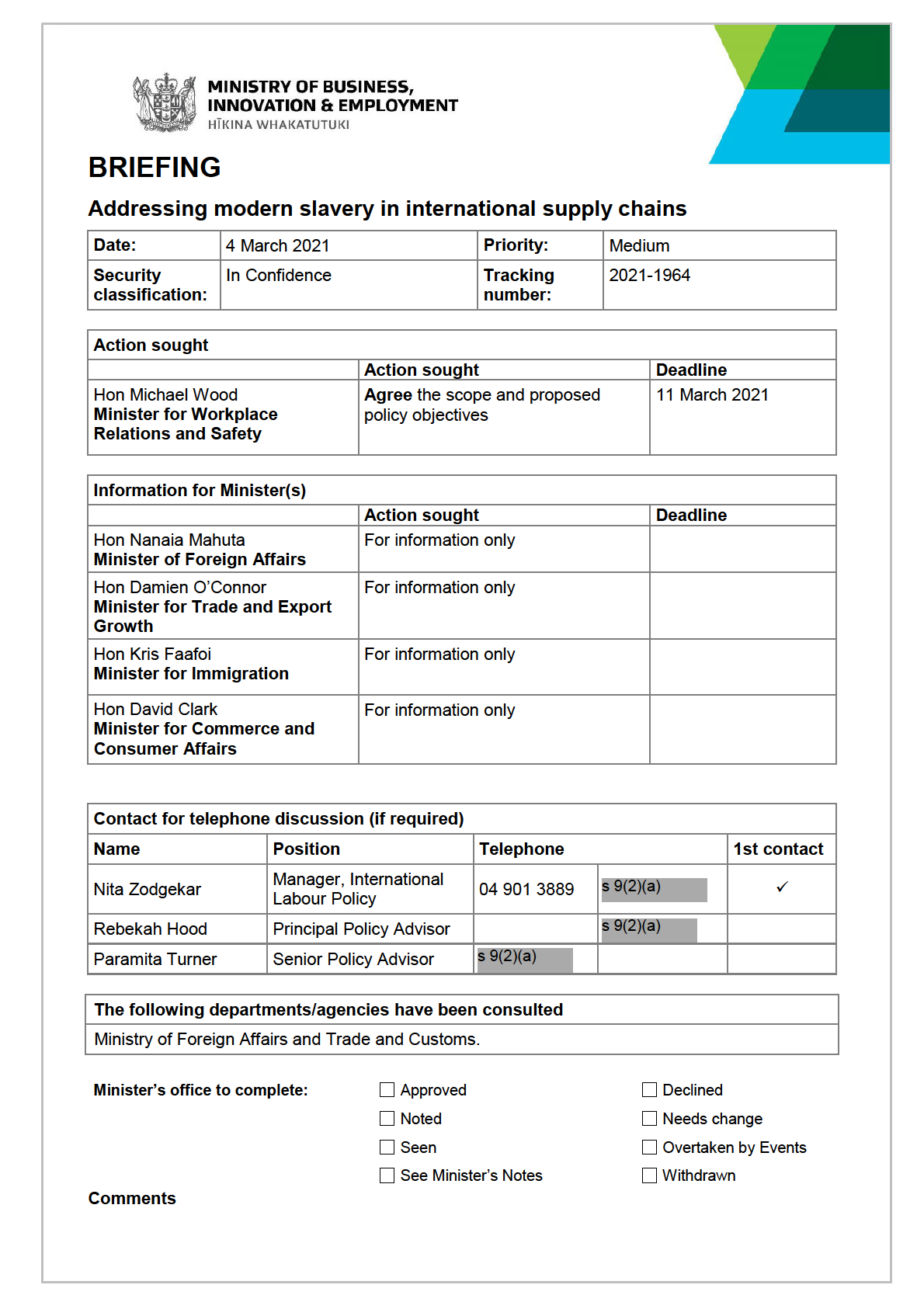


 BRI
EFING
Addressing modern slavery in international supply chains
Date:
BRI
EFING
Addressing modern slavery in international supply chains
Date:
4 March 2021
Priority:
Medium
Security
In Confidence
Tracking
2021-1964
classification:
number:
Purpose
To seek your agreement on the scope and proposed policy objectives for further work on options to
address modern slavery in international supply chains.
Executive summary
In November 2020, you directed officials to investigate whether we are adequately protecting
workers in New Zealand and elsewhere from modern slavery, including through the work on the
Plan of Action against Forced Labour, People Traf icking and Slavery and investigating the options
for addressing slavery through international supply chains.
This work also responds to the commitment in Labour’s 2020 Manifesto to
“[explore] the
implementation of modern slavery legislation in New Zealand to eliminate exploitation in supply
chains”.
Modern slavery is a significant problem that is found in every country. While there are significant
methodological challenges in attempting to estimate its scale, current estimates from the
International Labour Organization (ILO) suggest there are over 40 million victims of slavery around
the world (comprising 25 mil ion victims of forced labour, including sexual exploitation, and 15
million victims of forced marriage). We know that modern slavery is also occurring in New Zealand,
though our current information based on prosecutions is unlikely to reflect the full spectrum of
people who are trafficked or exploited in New Zealand.
New Zealand is delivering a robust framework for addressing exploitation domestically (including
through recent changes arising from the Migrant Exploitation Review), but it does not effectively
address modern slavery in international supply chains where slavery is found most often. While
New Zealand is actively engaged on these issues in bilateral and multilateral fora, there is an
opportunity to take further action to address modern slavery in international supply chains.
We recommend that further assessment of potential options to address modern slavery in
international supply chains be guided by the following policy objectives:
1.
Maintain and enhance our international reputation
2.
Reduce the prevalence of modern slavery internationally
3.
Raise awareness of modern slavery, and drive behavioural and cultural change
4.
Support New Zealand’s domestic framework in preventing exploitation, protecting
victims, and enforcing the law.
A wide range of approaches have been taken by other countries to address modern slavery in
supply chains. These approaches range from light touch to more intensive, and can include (for
example) specific awareness-raising initiatives, mandatory supply chain reporting obligations
through legislation, import bans on goods made with forced labour, and overseas development
assistance.
2021-1964
In Confidence
1
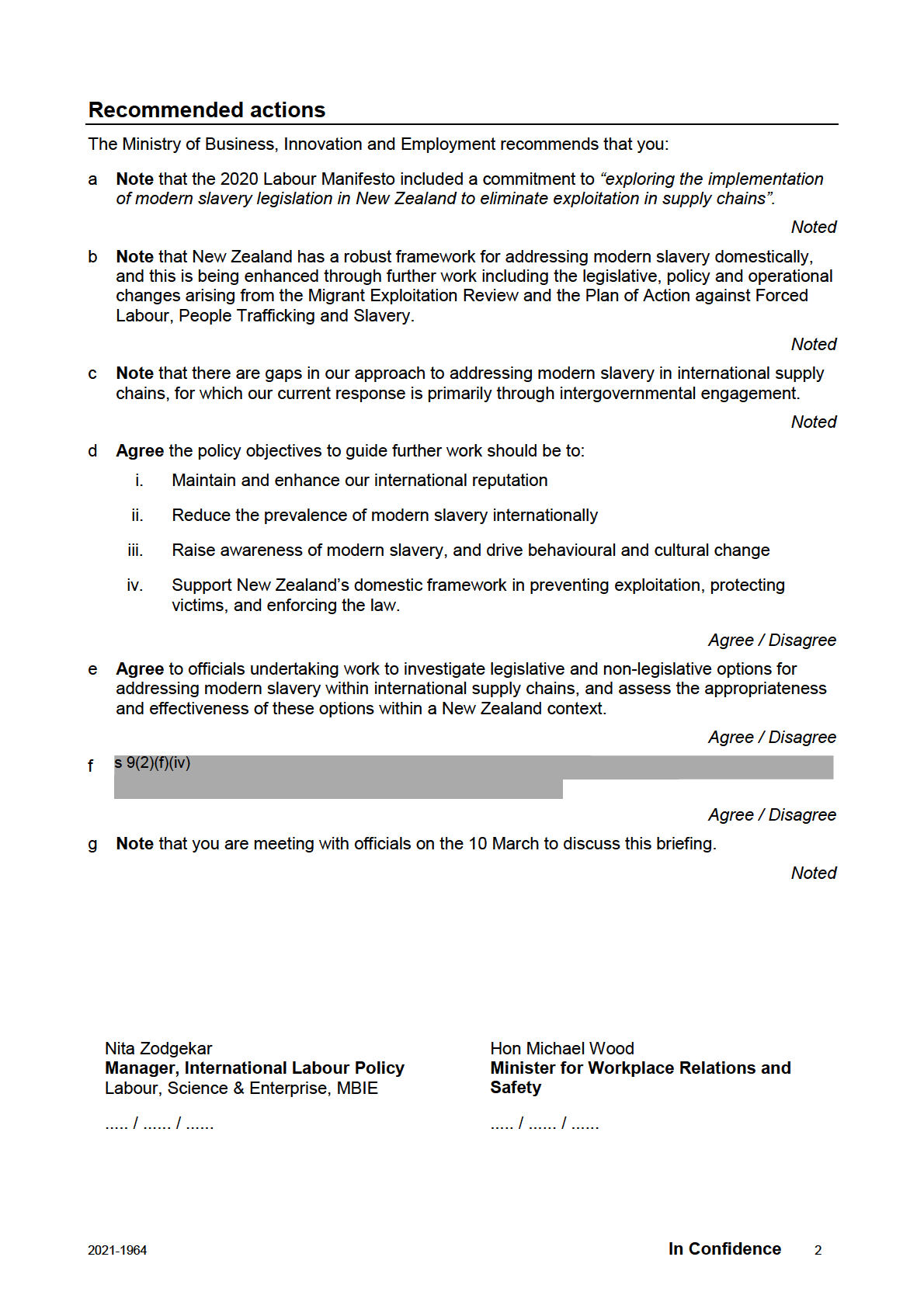

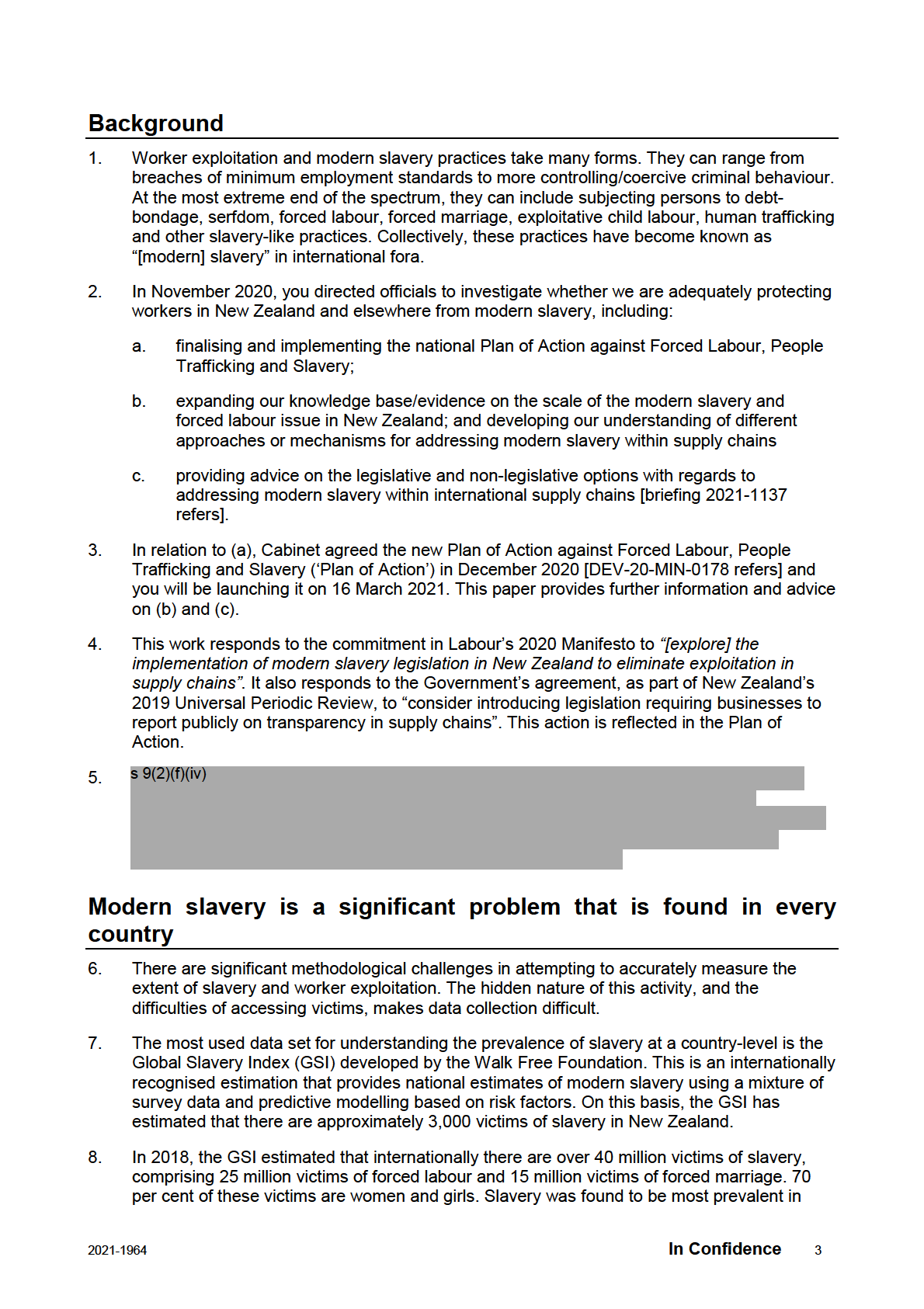


Africa, followed closely by Asia and the Pacific region. The Walk Free Foundation considers
that these estimates are conservative, given the gaps in data in key regions.
9.
A victim of slavery can face physical and emotional harm that can last for the rest of their
lives. This human suffering is hard to quantify or summarise, but can range from initial health
costs linked to physical or sexual violence through to mental health and wellbeing concerns.
10. The costs, whilst mostly felt in the domestic labour market that survivors are a part of, can
nevertheless contribute to wider economic impacts felt across the globe. Modern slavery can
include the denial of economic agency, which impacts international and domestic economies.
This can include significant impacts on productivity, which are felt throughout global supply
chains.
11. Current estimates on the extent and nature of these hidden crimes in New Zealand are
derived from overseas experience, and do not align with New Zealand’s experience to date.
Most of the 51 trafficking victims identified in New Zealand to date have been migrant men
who were trafficked for the purpose of labour exploitation. This is unlikely to reflect the full
spectrum of people who are exploited in New Zealand, as the hidden nature of these crimes
means that vulnerable people are less likely, or able, to seek help or report their experience.
12. Independent research commissioned by MBIE identified that exploited temporary migrant
workers suffer both physical and psychological harm, and that harm also af ects their
families. Key types of exploitation identified in the research included the under-payment or
non-payment of wages; non-compliance by employers with employment agreements; the
non-payment of taxes; and denial of annual holidays and holiday pay. Some workers
experienced controlling and coercive behaviours, such as surveil ance while working, control
of their accommodation and movement, intimidation, and threats related to their immigration
status.
13. Increasing awareness of the scale of the problem has helped draw attention to it, including
the role that businesses play in driving forced labour through international supply chains.
Global dialogue has increased in recent years as governments, businesses and non-
governmental organisations drive global efforts to tackle what is a global issue (for example
through the Bali Process1). This has led to greater awareness and also pressure for New
Zealand to take further action against modern slavery in international supply chains.
New Zealand is developing a robust framework for addressing
exploitation, and this is being further strengthened
14. New Zealand’s domestic legal framework criminalises the range of practices often associated
with modern slavery. This includes specific criminal provisions against slavery, dealing in
persons under 18 (including for sexual exploitation or forced labour), trafficking in persons
(including for sexual exploitation or forced labour), and the exploitation of unlawful
employees and temporary migrant workers. Immigration New Zealand and Police are directly
responsible for enforcement, and coordinate and cooperate as appropriate to address these
forms of offending.
15. The Plan of Action against Forced Labour, People Trafficking and Slavery includes an action
to consider amending the
Crimes Act 1961 to strengthen provisions for the criminalisation of
trafficking in those under 18 years.
16. New Zealand’s existing framework wil be further supported by the changes arising from the
Migrant Exploitation Review, which the Government initiated in 2018. In July 2020, Cabinet
1 The Bali Process on People Smuggling, Trafficking in Persons and Related Transnational Crime ("Bali
Process"), of which New Zealand is a member, was established in 2012 is a forum for policy dialogue,
information sharing and practical cooperation to help the region address these chal enges.
2021-1964
In Confidence
4
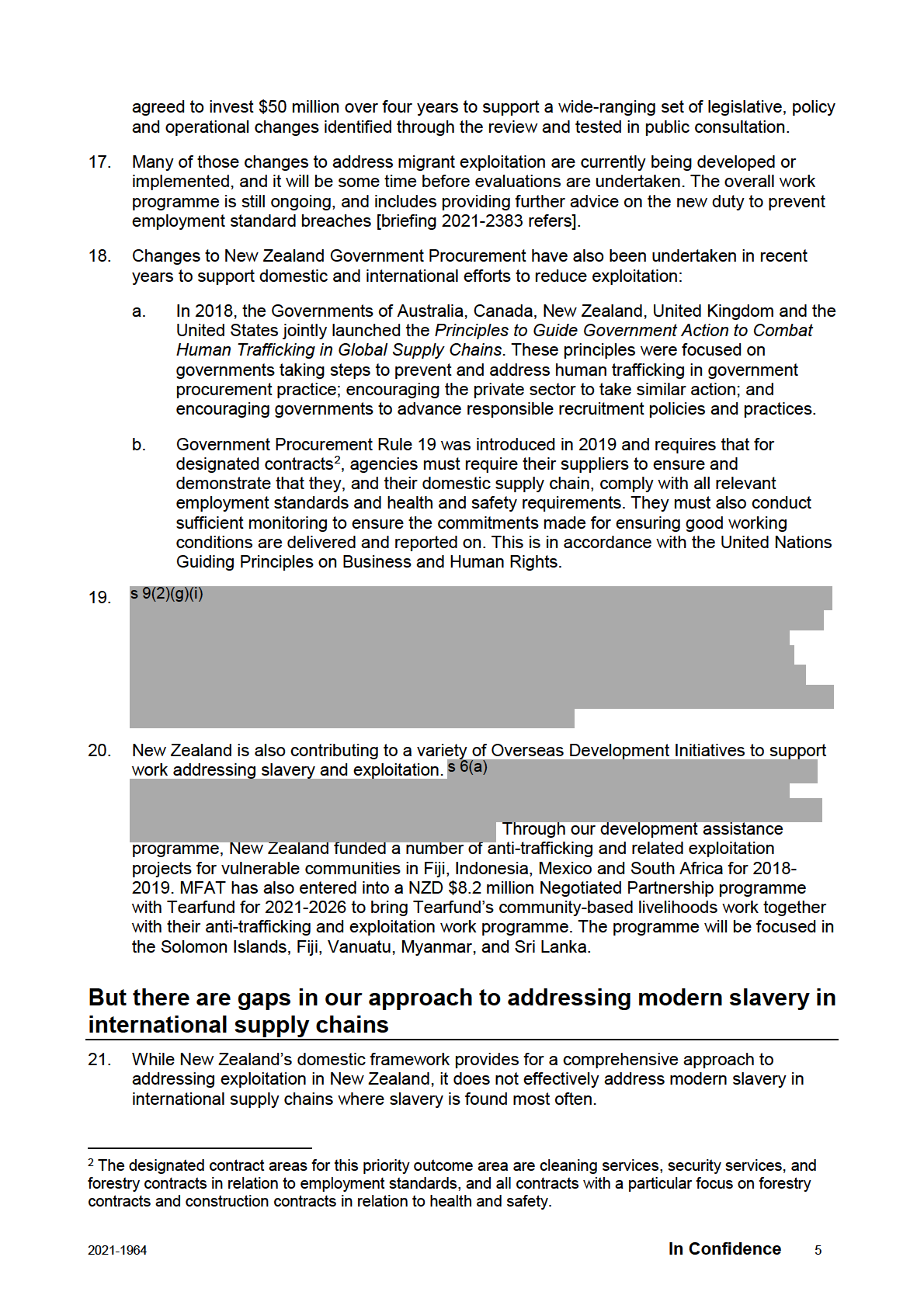


22. Currently, New Zealand’s engagement on these issues is primarily driven through bilateral
and multilateral engagement. This includes:
a.
Promoting the inclusion of labour chapters in Free Trade Agreements which place
obligations on parties in relation to the ILO’s Fundamental Principles and Rights at
Work (including the elimination of all forms of forced or compulsory labour).
b.
Engagement in multilateral fora, such as the:
i.
Bali Process on People Smuggling, Trafficking in Persons and Related
Transnational Crime (“Bali Process”), which brings together governments from
across Asia-Pacific to strengthen cooperation against these practices. This
includes active participation in the Bali Process Government and Business
Forum, which enables engagement between governments and the private sector
to combat human trafficking and related exploitation.
ii.
Pacific Island Forum Fisheries Agency and the Western and Central Pacific
Fisheries Commission (WCPFC). In the WCPFC, New Zealand is leading work to
improve labour standards on fishing vessels through the development of legally
binding measures.
23. New Zealand also has an ongoing presence in a range of countries which involves
supporting both those countries and New Zealand to address exploitation and forced labour.
This includes:
a.
Sharing information on forced labour, people trafficking and slavery through the Pacific
Island Development Community (PIDC)
b.
Providing support through immigration liaison officer positions in South-East Asia
c.
Developing capacity building modules on trafficking in persons, forced labour and
slavery to Pacific Island partners as part of the Hakili Matagi Immigration Core
Elements Curriculum
d.
Offshore presentations that support the disruption and prosecution of forced labour,
people trafficking and slavery (through channels such as the Bali Process, Fiji Police
and Immigration workshops, the Samoan Police awareness programme, offshore INZ
Risk and Verification Manager training).
24. While these engagements are not specifically focused on preventing modern slavery in
supply chains, reducing forced labour and trafficking within the Pacific and South-East Asia
regions can assist in protecting the integrity of goods and services supplied to New Zealand
enterprises.
25. Addressing this issue further may contribute to sustaining the social licence for New Zealand
trade policy and is consistent with New Zealand’s long-held active approach to human rights
issues. The Government has accepted the Trade for Al advisory board’s recommendation to
review legislation to ensure forced labour is adequately addressed.
26. During the development of the Plan of Action, a targeted public consultation was carried out
with key stakeholders including across civil society and business. The majority of
respondents (28 out of 37) to the consultation commented specifically on Action 16, to
“C
onsider introducing legislation requiring businesses to report publicly on transparency in
supply chains, to help eliminate practices of modern slavery”. Al who commented were in
favour of this action, and most submit ers also recommended that it be treated as a major
priority.
27. In addition, there has been a significant rise in news coverage and public interest on modern
slavery issues. You have been lobbied, as have officials, regarding the potential for modern
2021-1964
In Confidence
6

slavery legislation in New Zealand. This has included a call by the Walk Free Foundation for
New Zealand to conduct an official inquiry into the need for legislation, as Australia did in
2017.
28. The Ministry of Foreign Affairs and Trade (MFAT) have also been approached by civil society
groups such as the Business and Human Rights Resource Centre, encouraging the
Government to support work throughout the Pacific and in our own development programme
procurement processes, to promote compliance with the UN Guiding Principles on Business
and Human Rights.
29. The Walk Free Foundation (which produces the Global Slavery Index) ranked New Zealand
52nd out of 183 countries assessed based on their responses to modern slavery3. One of
Walk Free’s criticisms of New Zealand was the lack of response to international supply
chains and the impact of New Zealand businesses in this context.
Market failures suggest the need for further government intervention
30. Modern slavery presents a significant social and financial cost to victims and their
communities. It also presents a competitive disadvantage for businesses that conduct
trade fairly, and is a barrier to productive, inclusive and sustainable economic growth.
31. There is also an increasing societal expectation for transparency in supply chains, including
on the prevalence of modern slavery within them, which may have future trade implications.
32. Furthermore, there is an opportunity for New Zealand to take a leadership role with
government support for actions that address modern slavery. The need for a more level-
playing field based on minimum standards of business practice, in combination with the
public good outcomes that could be achieved by such practice, suggests that government
intervention may be warranted in this case. Proposed policy objectives and potential
interventions are discussed in more detail below.
We propose four policy objectives to guide further work to address
modern slavery in international supply chains
33. We recommend that the following policy objectives guide the next stages of this work:
1.
Maintain and enhance our international reputation
2.
Reduce the prevalence of modern slavery internationally
3.
Raise awareness of modern slavery, and drive behavioural and cultural change
4.
Support New Zealand’s domestic framework in preventing exploitation, protecting
victims, and enforcing the law.
34. These objectives will inform further work on policy options for addressing modern slavery
within international supply chains. Any assessment wil also include consideration of the cost-
effectiveness of each intervention.
Objective 1. Maintain and enhance our international reputation
35. As a small nation lacking significant economic and strategic power, New Zealand is
dependent on strong international connections and the rules-based multilateral system. It is
through these connections that New Zealand influences relevant agendas and it is
recognised as a strong advocate of international law, sustainable development, and human
rights. Our reputational strength lies in our observance of international standards and
3 Walk Free Initiative: Measurement, Action, Freedom, June 2019
2021-1964
In Confidence
7
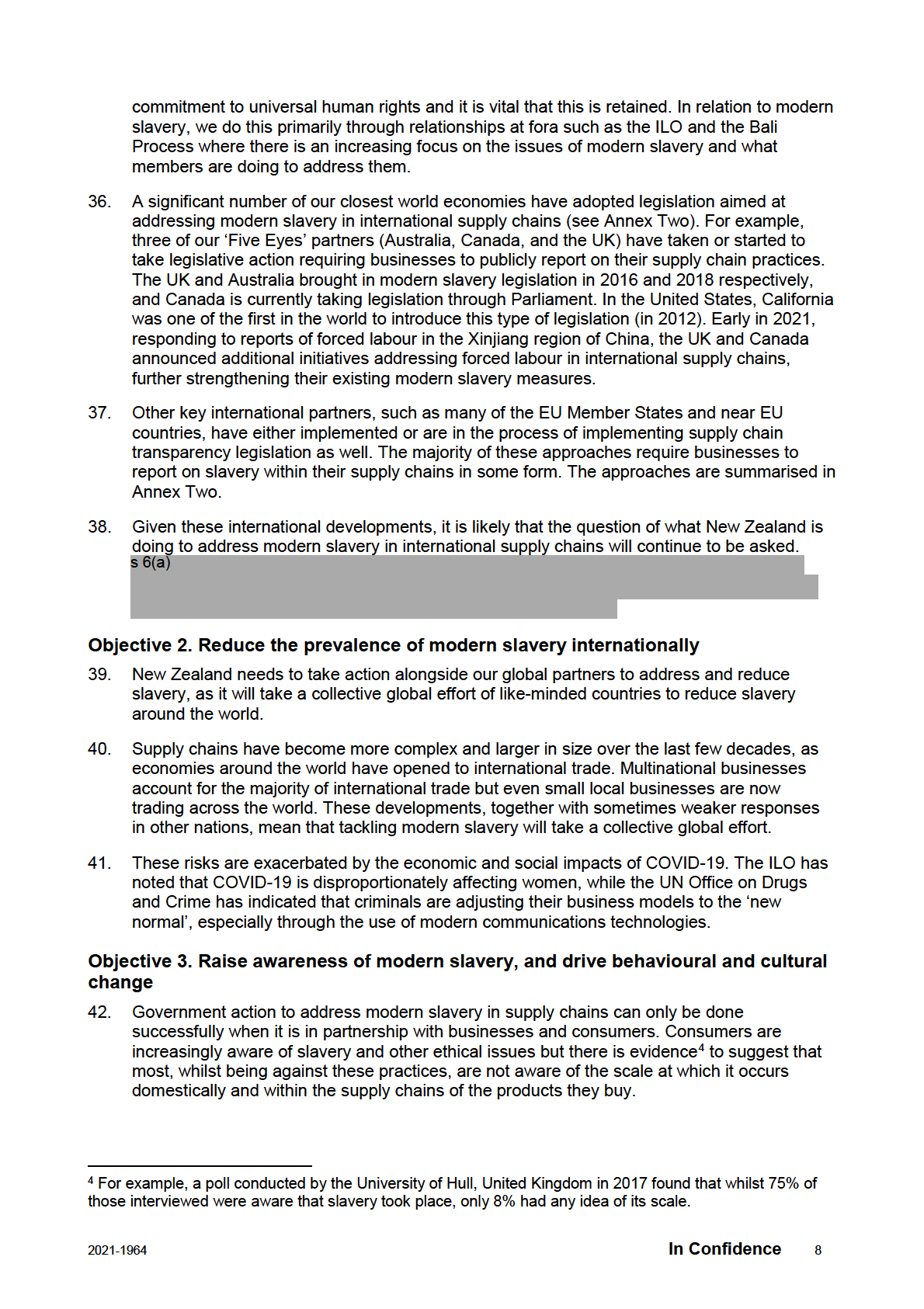


43. We expect that businesses do not want slavery to exist within their supply chains, including
for the purpose of avoiding legal and reputational risks. There may also be a financial
business case for eradicating slavery within supply chains, as well as a moral one. A report
by the CORE Coalition5 discussed the benefits to businesses as ranging from improved risk
assessment and investor relations, through to increased staf retention and improved
relationships with consumers in an increasingly ethically conscious market. Conversely,
Sports Direct (a large UK based business) lost 11 per cent from its share price in the wake of
serious allegations of how workers were treated.
Objective 4. Support New Zealand’s domestic framework in preventing exploitation,
protecting victims, and enforcing the law
44. Taking action on slavery in international supply chains should work in partnership with the
domestic framework already established, the changes taking place following the Migrant
Exploitation Review and the actions agencies have commit ed to through the Plan of Action.
45. Measures to address modern slavery in supply chains can help to increase the publicity of
these practices domestically. An independent review of the UK Modern Slavery Act
suggests it has helped increase awareness of modern slavery and led to an increase in
reporting to the police. The number of live police investigations into modern slavery in the UK
increased from 188 in December 2016, to 1,640 in May 2020. In addition, in 2019 there was
a 67 per cent increase in offences identified compared to 2018, resulting in a 17 per cent
increase in prosecutions and 27 per cent increase in convictions for modern slavery-related
crimes.
46. There may also be parallels between the new duty to prevent employment standards
breaches currently under development [briefing 2021-2383 refers] and the supply chain
management and transparency obligations that are typical to modern slavery legislation. The
new duty to prevent employment standards breaches wil apply to lead firms’ domestic
supply chains, and not their international supply chains (as in modern slavery legislation).
However, the responsible business conduct it wil incentivise may complement any
international supply chain reporting and management obligations that could be included in a
Modern Slavery Act in New Zealand, were such legislation to be introduced.
There are a range of possible interventions to address modern
slavery in supply chains
47. There are various approaches taken by other countries globally, which New Zealand is not
currently doing, to address the issue of modern slavery in supply chains. These approaches
range from light touch to more intensive, and include the following:
•
Supply chain transparency through mandatory reporting and other due diligence
obligations (through legislation)
•
Awareness campaigns with consumers and businesses, including providing best
practice guides
•
Creating a new office as a watchdog over businesses
•
Facilitating business leadership
48. These approaches are discussed below and summarised in Annex Two.
49. There are limited evaluations available for these approaches, as many have either been
recently adopted or are under development. However, initial evaluations are starting to
5 CORE is a UK civil society coalition on corporate accountability.
2021-1964
In Confidence
9

emerge for those approaches with have been in place for a longer period of time, which are
discussed below.
International approaches to addressing modern slavery in supply chains
Supply chain transparency through mandatory reporting and other due diligence obligations
(legislation)
50. Supply chain legislation has been introduced in other countries requiring large businesses to
report publically on slavery within their international supply chains, including the steps they
are taking to address any problems. This does not seek to enforce the labour laws of each
country in foreign jurisdictions, but rather supports international laws and agreed standards.
There are various forms and approaches that these interventions have taken.
51. The legislation takes many different forms in each jurisdiction. Jurisdictions vary in terms of
the size of businesses they target and the related support (eg independent commissioners
and toolkits). There are also differences in the level of duty placed on organisations. Some
require public statements of efforts to identify slavery; others have a requirement to
thoroughly audit supply chains; and some (such as the EU) go further by placing a duty of
care liability to prevent and protect workers in supply chains from exploitation.
52. Supply chain transparency legislation seeks to raise awareness domestical y and
internationally of these issues. It drives modern slavery into the public and business domain
to contribute to the eradication of these practices through consumer choice and business
relationships. Further, it intends to raise awareness that this activity can also occur
domestically, and by creating more public responsibility and awareness, lead to an increase
in prosecutions.
53. The UK was one of the first countries to implement a Modern Slavery Act (MSA) in 2016 with
supply chain reporting requirements, although the US state of California had brought in
similar legislation in 2012. Since the UK, other countries have followed suit including the EU
Member States and Australia, and Canada is considering adopting a similar approach.
54. This approach has been supported in the UK and Australia by the development of a public
repository of reports, and establishment of units to support good business practice.
55. Financial penalties for non-compliance have been a controversial component of this
approach. The UK MSA now includes a financial penalty if businesses do not comply with the
requirements of the statements, following an independent review of its law. Australia will be
reviewing whether penalties should be introduced as part of a forthcoming statutory review of
the legislation.
56. This approach varies in terms of which businesses are targeted. This is usually decided
through specifying a threshold based on revenue or number of employees.
57. There is a question of how many New Zealand businesses trading internationally are already
reporting in other countries as a result of their legislation. However, more work needs to be
done to understand this number further. This must be done in conjunction with assessing the
requirements of each one of these approaches and any gaps which may exist; as well as
how they meet the policy objectives outlined above.
58. There are limited evaluations for the legislative approach as many are stil new. However, an
independent review of the UK approach suggested it had helped increase awareness of
modern slavery and led to an increase in reporting to the police. This has in turn resulted in
2021-1964
In Confidence
10

an increase in the number of prosecutions and convictions. There is also evidence6 that
voluntary initiatives do not on their own, drive compliance.
Awareness campaigns with consumers and businesses, including providing ‘best practice guides’
59. Examples of this type of initiative include Walk Free Foundation’s Business and Investor
Toolkit, the UN Guiding Principles on Business and Human Rights, OECD Guidelines for
Multinational Enterprises and New Zealand’s own work on Procurement Principles and
ethical and sustainable work practices through Employment New Zealand.
60. These awareness campaigns contain a range of information and guidelines which include:
a.
Advice on why businesses should care about slavery in their supply chains and
generally from both a moral and business perspective
b.
Tools to use to take action such as listing firms who can help with auditing supply
chains
c.
Links to other examples of best practice and resources from other businesses and
international organisations.
61. These initiatives could benefit from being more cost effective to implement and designed to
harness action from businesses which want to independently take action for commercial
reasons, and also to reinforce their own values.
62. However, as discussed in paragraph 58 above, evidence7 suggests that these voluntary
initiatives alone wil not drive wholesale change in this area. It therefore does not directly
target those who are not already motivated to take action in this space.
Creating a new office as a watchdog over businesses
63. In Canada, the role of Ombudsperson for Responsible Enterprise was established in 2018
and mandated to investigate allegations of human rights abuses linked to Canadian
corporate activity abroad. The Ombudsperson undertakes collaborative and independent
fact-finding, makes recommendations, monitors implementation of those recommendations,
and reports publicly throughout the process.
64. In the UK, an Anti-Slavery Commissioner role has also been established through legislation
as part of the modern slavery response. Its role includes advocating for victims and the
elimination of these practices, and holding the government to account.
65. There are limited evaluations of the effectiveness of this approach but more analysis wil be
completed over the coming weeks. It is also worth noting that the UK Anti-Slavery
Commissioner is part of its legislation and compliments its mandatory reporting. Canada is
implementing similar legislation as well.
Facilitating business leadership
66. There is an opportunity to facilitate business leadership to drive the adoption of practices to
address modern slavery in supply chains. A key barrier is the lack of coordination across
businesses, meaning there can be lit le visibility over how actions are implemented in
practice.
67. The Government currently leverages procurement to drive good employment practices in the
domestic supply chains of contracted businesses (particularly in the cleaning, security and
forestry sectors). However, more could be done to facilitate best-practice information sharing
6 United Nations: Report of the working group on the issue of human rights and transnational corporations
and other business enterprises, 16 July 2018 (A/73/163)
7 United Nations: Report of the working group on the issue of human rights and transnational corporations
and other business enterprises, 16 July 2018 (A/73/163)
2021-1964
In Confidence
11

to support efforts to improve these practices across international supply chains. This could
follow from approaches that have been undertaken to promote environmental sustainability,
such as the organising of fora and engagement with key business groups, while involving
others including unions and NGOs.
Other considerations in combatting modern slavery in supply chains
68. This work on supply chain transparency is specifically focused on ensuring that businesses
are taking action to address modern slavery in their own supply chains. Actions can also be
taken to address modern slavery outside of a supply chain transparency approach. These
interventions include directly stopping the flow of goods made as a result of slavery, or
tackling the root causes of such practices (including through overseas development
assistance). They are therefore primarily foreign policy and trade issues and any further work
would need to be prepared through those portfolios.
Placing import bans on goods made with forced labour
69. The US has prohibited the import of any products produced wholly or in part by forced
labour. Canada is considering the introduction of legislation which would enable it to similarly
ban the import of goods produced with forced labour. Some countries have implemented
bans on specific products and regions associated with allegations of forced labour. For
example, the US issued a Withhold Release Order against cotton products and tomato
products produced in Xinjiang in January 2021. The Australian Senate is currently
considering a Bil that would prohibit importation of all goods from Xinjiang region and other
regions in China using forced labour.
70. In New Zealand, two previous Bills proposing to ban foreign slave labour goods (in 2009 and
2016) failed to progress, due to difficulties in defining slavery or forced labour and the ability
to enforce such a ban. There is currently no feasible way to assess the exact origin of goods
and the conditions under which they were produced.
71. More work would need to be undertaken to understand if this approach could be re-worked to
make it a feasible option for New Zealand. This would include consideration of how well it
has worked in other jurisdictions s 9(2)(f)(iv)
Addressing controls on the export of goods to prevent their diversion towards forced labour
72. Another consideration in combatting forced labour in international supply chains is
addressing whether measures could be adopted to ensure goods exported overseas are not
used as inputs to products produced by forced labour, or are not diverted towards
repression, arbitrary detention or forced labour, for example security equipment.
73. Under New Zealand’s current export controls regime, exports which may be used (directly or
indirectly) for a military, paramilitary, militia or police purpose require an export permit. There
is, however, limited scope for exploring if export controls could be widened to more
effectively control for goods which could contribute to forced labour. This would involve
legislative change to the definition of ‘military’ to ‘security’ which could then encompass other
internal security organisations.
Targeting overseas development assistance initiatives
74. Practices associated with modern slavery can be addressed through programmes such as
those led by the ILO and the International Organization for Migration (IOM), which can be
reliant on external funding including from governments and businesses.
75. As summarised earlier, New Zealand currently contributes to a range of overseas aid
projects which are working towards reducing the instances of slavery globally. These range
from partnerships with Tearfund to work with their anti-trafficking and exploitation projects
s 6(a)
2021-1964
In Confidence
12
